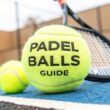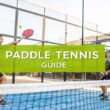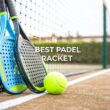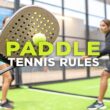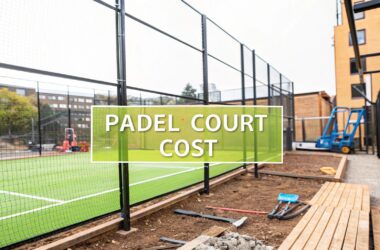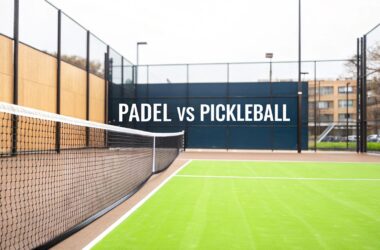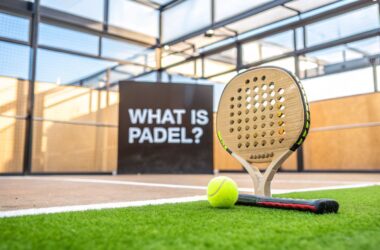Padel court construction is absolutely booming right now. Why? The sport is incredibly accessible, highly social, and frankly, offers a fantastic return on investment for clubs and developers. Plus, its smaller footprint compared to a tennis court makes it a versatile addition to just about any facility, which is driving a massive global surge in demand for new courts.
The Unstoppable Rise of Padel and What It Means for You
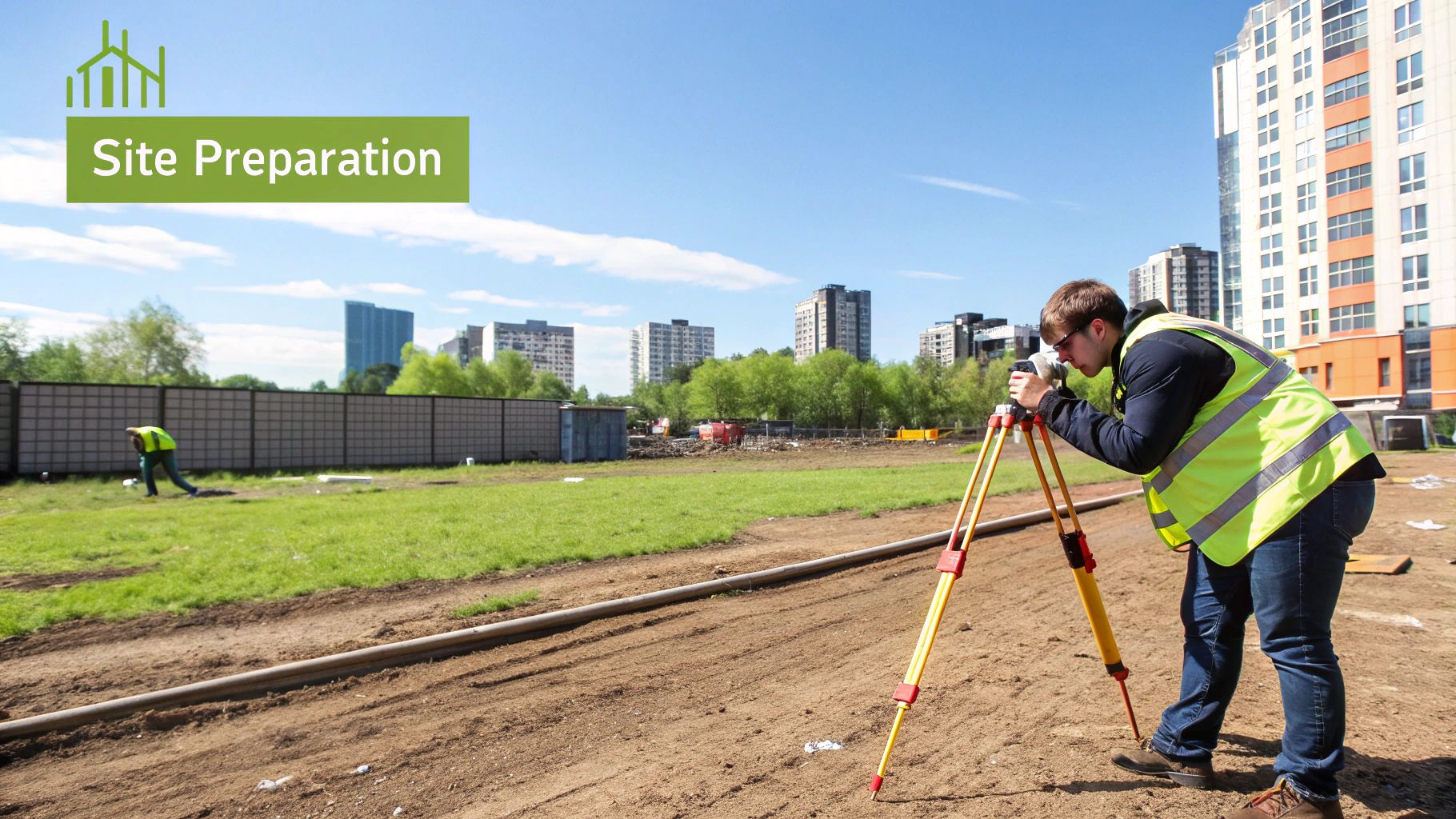
It’s pretty much impossible to ignore the meteoric rise of padel. What was once a niche racket sport is now a full-blown global phenomenon, and the demand for quality courts is skyrocketing. This isn't just some fleeting trend; it’s a real shift in recreational sports, all thanks to its unique mix of accessibility and community.
Unlike tennis, padel has a much lower barrier to entry. New players can genuinely pick up the basics and enjoy a rally within their very first session, making it instantly rewarding. The enclosed court and the use of the walls keep the ball in play longer, leading to dynamic, fast-paced games that are as fun to watch as they are to play.
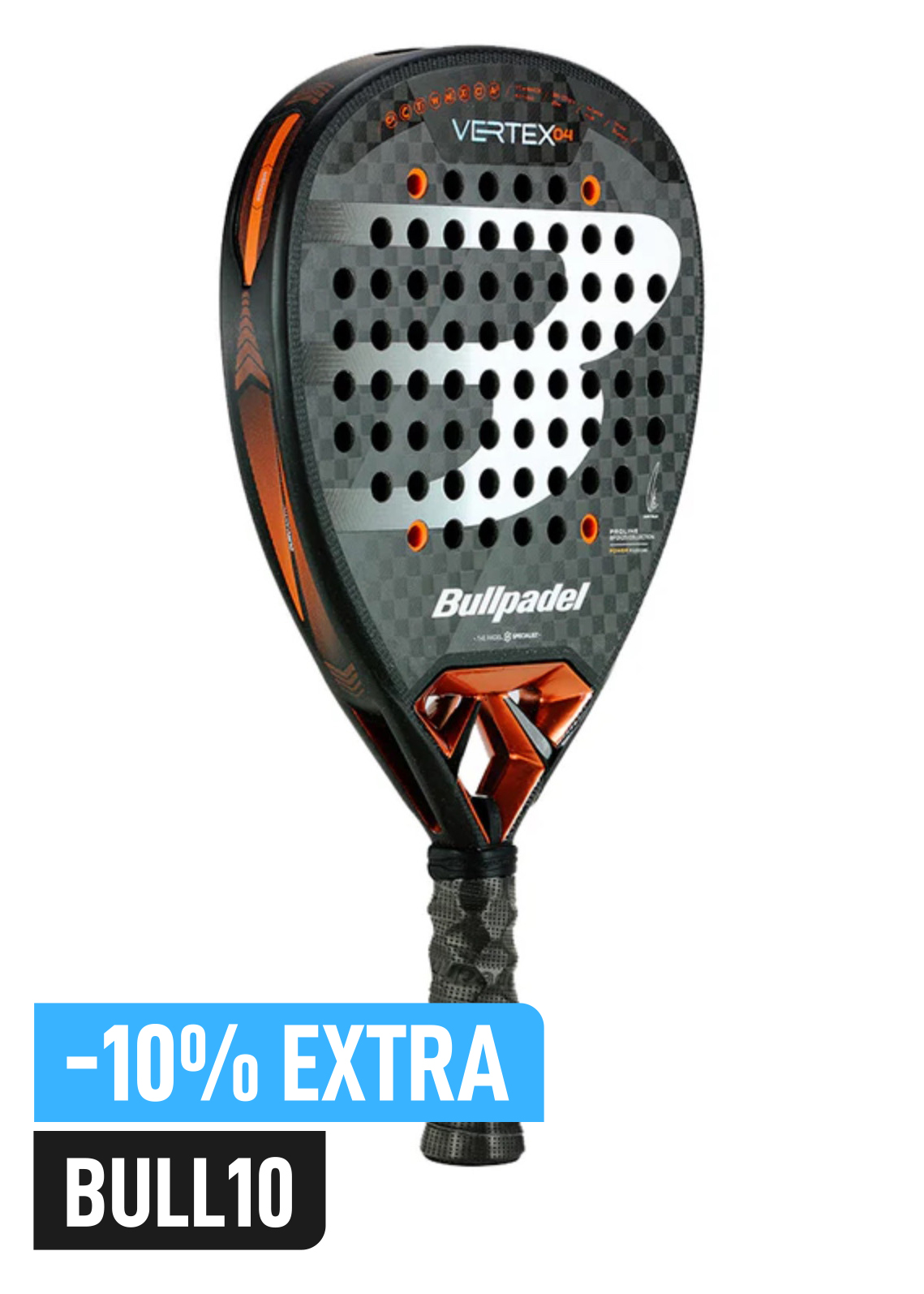
Buy the best padel gear to level up your next game!
CHECK OUT this deal from Padel Market!Get ready to take your game to the next level with the latest padel gear from Padel Market! Fast EU and Worldwide Shipping
Why Is Padel So Addictive?
The social element is a huge part of its popularity. Always played in doubles, padel is inherently a community-building activity. It’s totally common to see players of different ages and skill levels sharing a court, which fosters a friendly, inclusive atmosphere that many other sports just don't have.
This unique combination makes padel a powerful tool for:
- Attracting New Members: Sports clubs are adding padel courts to draw in a wider demographic, from young families to seasoned athletes looking for a new challenge.
- Boosting Revenue Streams: You can often fit two or even three padel courts into the footprint of a single tennis court, effectively doubling or tripling your potential rental income.
- Enhancing Property Value: For developers and even homeowners, a padel court is a modern, desirable amenity that can significantly increase a property's appeal.
The Numbers Behind the Boom
The growth statistics are staggering. Recent data shows that the global infrastructure now includes over 50,000 padel courts, with thousands more being built every year.
This expansion is fueled by an average of nearly nine new clubs opening every single day worldwide—that’s a new club roughly every two and a half hours. This represents a 17% year-over-year growth in courts, which just shows the incredible momentum behind this sport. You can learn more about the scale of this global padel explosion and its market impact.
A key takeaway for anyone considering padel court construction is this: you are not just building a sports facility; you are creating a social hub. The design, materials, and overall environment should reflect this to maximize player engagement and your return on investment.
Think of this guide as your starting point for turning that opportunity into a reality. We’ll walk you through every critical decision, from initial site selection and navigating permits to choosing the right materials and understanding the full build process. By the end, you’ll have a clear roadmap for your own padel court construction project.
The boom is here, and it’s time to be a part of it.
Navigating Site Selection and Permits
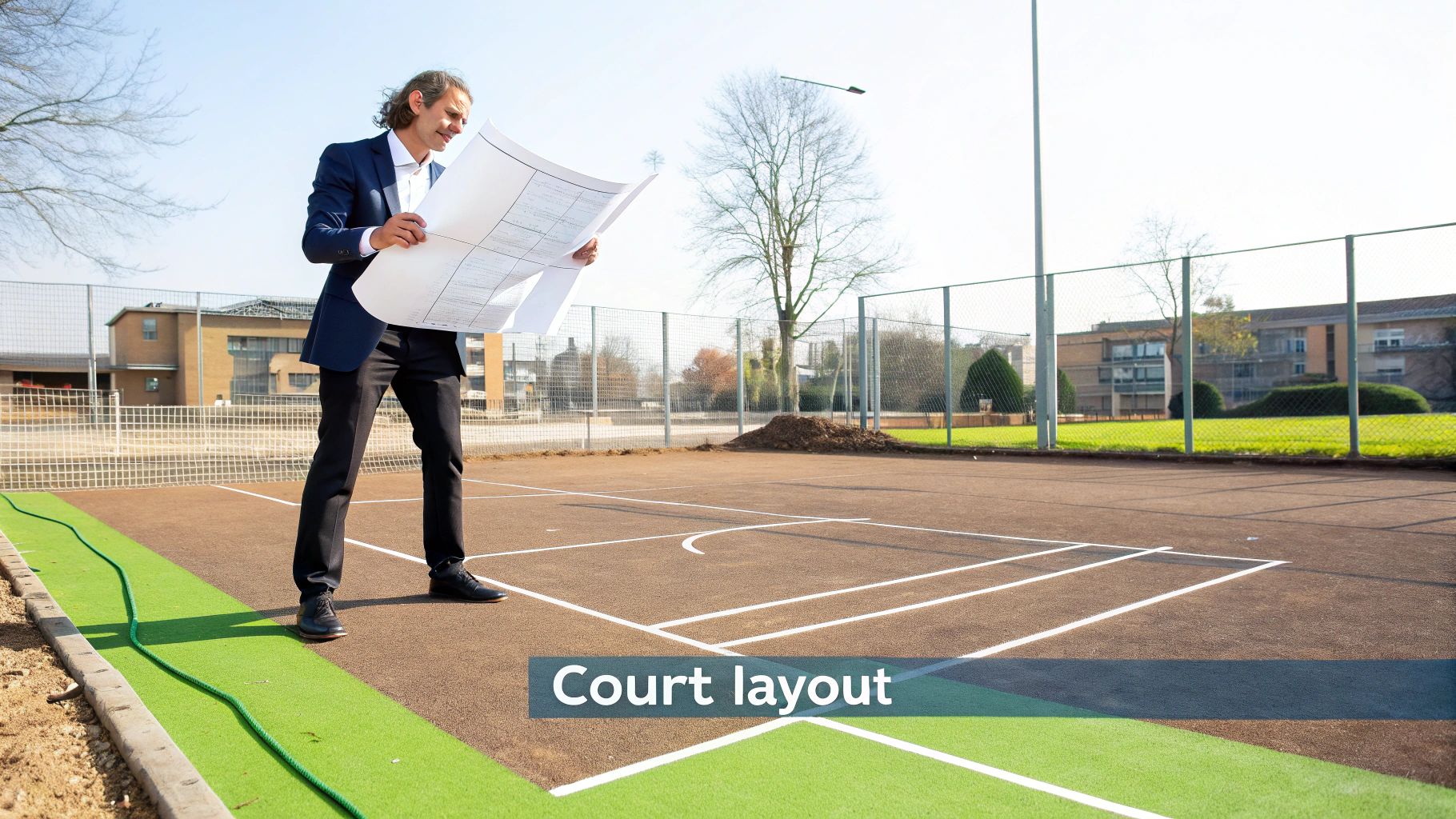
Before you even think about mixing concrete, the success of your padel court project hinges on two things: where you decide to build it and getting the official green light to do so. Get these two steps right from the very beginning, and you'll save yourself from a world of expensive headaches, frustrating delays, and potential legal trouble later on.
Choosing your site is so much more than just spotting an empty piece of land. It's a serious evaluation of the ground's stability and the surrounding environment. Picking the wrong spot can quickly turn your dream court into a recurring maintenance nightmare.
Think about it: a location with poor natural drainage might seem perfectly fine on a sunny day. But after the first big storm, you could be looking at a waterlogged foundation, which is a recipe for long-term structural damage. An uneven site is another classic pitfall, demanding major excavation and leveling work that adds surprising costs and time to your project. Don't forget the simple stuff, either—like making sure construction crews and, eventually, players can actually get to the court easily.
Evaluating Your Potential Site
Treat your potential site like you're interviewing it for a crucial job. The perfect spot isn't just flat; it needs to be stable enough to support a heavy concrete slab for decades without shifting or cracking.
Here’s what you absolutely must check off your list:
- Ground Stability: The soil has to be compact and solid. If you're dealing with loose, sandy, or clay-heavy soil, be prepared for extensive groundwork and reinforcement, which will drive up those initial costs.
- Drainage and Water Table: Is the area known for flooding? A high water table or poor drainage is a direct threat to your court's foundation. Ideally, you want a gentle, natural slope that carries water away from the court area.
- Accessibility: How are the big trucks going to get in? Tight corners, narrow gates, or low-hanging power lines can turn the delivery of materials and heavy equipment into a logistical nightmare.
A professional geotechnical survey is an investment that pays for itself. It gives you a detailed report on soil composition, groundwater levels, and bedrock depth—the hard data you need to confirm a site is viable before you sink any serious money into it.
Demystifying Permits and Zoning Laws
Once you've scouted a promising location, it's time to face the administrative beast: permits. For most newcomers to padel court construction, this is easily the most intimidating part. Zoning laws, building codes, and local ordinances can feel like an impossible maze of red tape.
Your first move should be to get in touch with your local municipal planning or building department. They are the ultimate source for what's required in your specific area. Regulations can change dramatically from one town to the next, so never assume the rules you heard about in a neighboring county will apply to you.

Buy the best padel gear to level up your next game!
CHECK OUT this deal from Padel Market!Get ready to take your game to the next level with the latest padel gear from Padel Market! Fast EU and Worldwide Shipping
You'll need to dig into your property's zoning classification to make sure a sports facility is even allowed. In some cases, you might need to apply for a special use permit or a zoning variance, which often involves a public hearing process.
Assembling Your Permit Application
When it comes to your permit application, being over-prepared is the name of the game. A complete, well-organized package can dramatically speed up the approval process.
Your application will almost certainly need to include:
- Site Plans: These are detailed drawings that pinpoint the court's exact location on the property. They must show setbacks from property lines, nearby structures, and any easements.
- Construction Drawings: Think professional blueprints. These need to outline the court's structure, foundation specs, drainage systems, and the specific materials you'll be using.
- Lighting and Environmental Plans: If you're planning for night play, you’ll need to show that your lighting won't create a nuisance for neighbors. You may also have to submit a plan for handling storm-water runoff.
For commercial projects, the requirements are typically much stricter. If you're building a court for a club or business, it's crucial to review detailed guides on commercial building permit requirements to ensure you're fully compliant. And for more insights on the latest trends in the padel world, Padel Rumors keeps you covered in our section on padel court news and developments.
Tackling this phase with diligence is the bedrock of a successful project. It ensures your court is built on solid ground—both literally and legally.
Choosing Your Court Materials and Surfaces
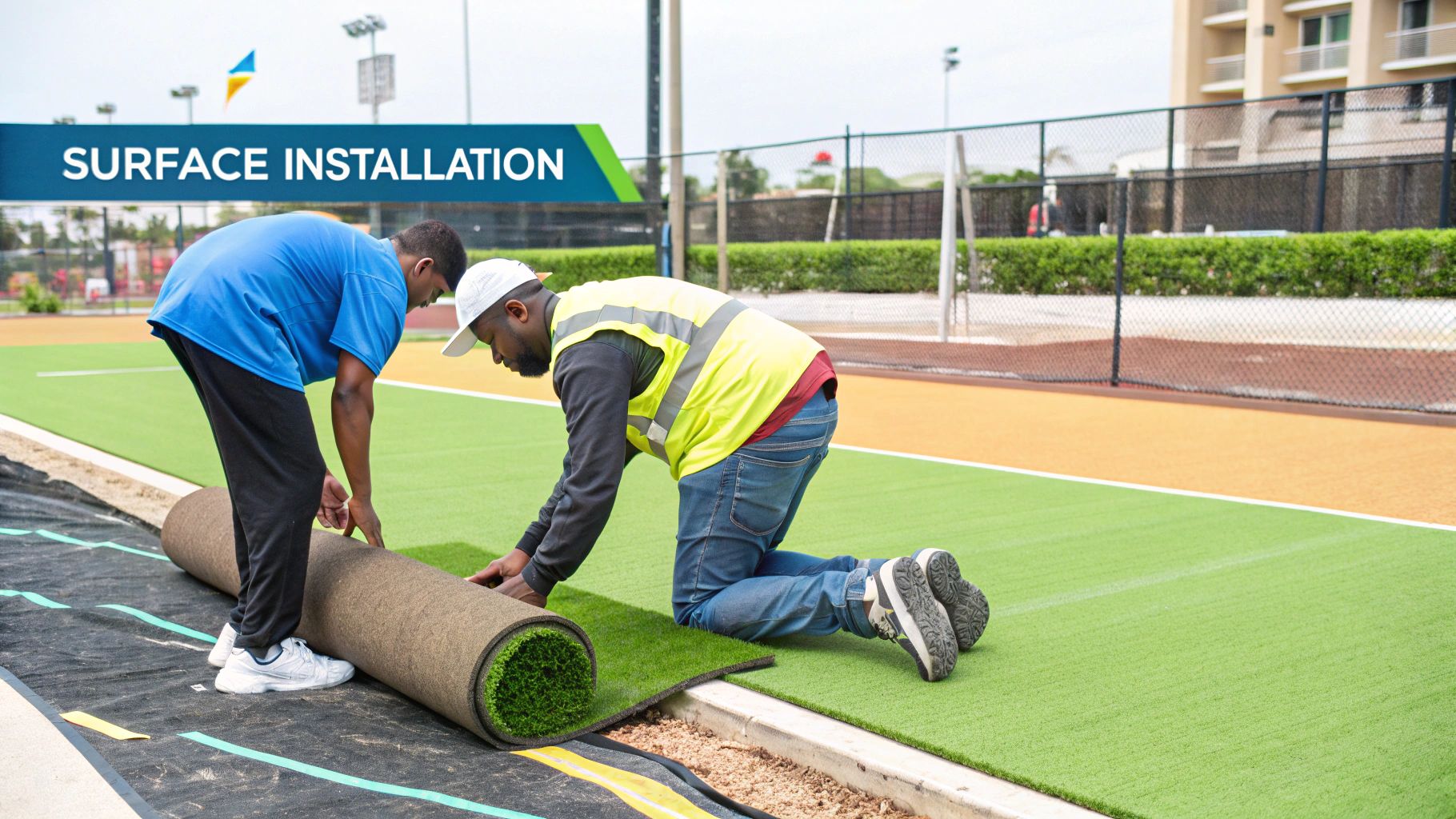
The decisions you make about materials will define every single game played on your court. Seriously. From the feel of the turf under a player's feet to the quality of light for a night match, these choices shape the entire experience. They also have a massive impact on your court's lifespan and long-term maintenance costs. Getting this right is a classic balancing act between your budget, the performance you want, and the durability you need.
Let's start with what's arguably the most critical component for actual gameplay: the surface. It dictates everything—ball bounce, player grip, and overall safety. While you might see a few different options out there, artificial turf is the undisputed king in modern padel. But here's the catch: not all turf is created equal. The differences are huge.
Selecting the Perfect Playing Surface
You'll mainly be choosing between two types of artificial turf: monofilament and fibrillated. They might look similar at a glance, but their construction changes everything from the speed of the game to how often you'll be out there with a brush.
- Monofilament Turf: This is the top-shelf option you see in professional tournaments. Each fiber stands up on its own, which lets the silica sand infill settle down deep between the blades. The result? A faster, more consistent ball bounce and a surface that allows for clean pivots and slides, which is a big deal for reducing joint injuries.
- Fibrillated Turf: This type uses wider fibers that are split at the top, kind of like a net. It's friendlier on the wallet, but it tends to hold the sand closer to the surface. This creates a slightly slower game and means you'll need to brush it more often to keep the sand distributed and prevent it from getting compacted.
If you're building a club to attract serious players or host competitions, investing in monofilament turf is a no-brainer. For a private court or a more casual facility, fibrillated turf is a solid, cost-effective choice that will serve you well.
Comparing Padel Court Material Options
Making sense of all the components can be a headache. This table breaks down the most common materials you'll be choosing from, giving you a clear look at the pros and cons for each part of the court.
| Component | Material Option | Advantages | Considerations |
|---|---|---|---|
| Playing Surface | Monofilament Turf | Professional feel, fast/consistent bounce, better for player joints. | Higher initial cost. |
| Playing Surface | Fibrillated Turf | More affordable, durable for recreational use. | Slower gameplay, requires more frequent brushing to spread sand. |
| Structural Frame | Galvanized Steel | Very strong, durable, and cost-effective. The industry standard. | Can be susceptible to rust in very humid or coastal climates. |
| Structural Frame | Aluminum | Excellent corrosion resistance, lighter weight. | Significantly more expensive than steel. |
| Glass Walls | 10mm Tempered Glass | Meets safety standards, sufficient for most recreational courts. | Less rigid and offers less sound dampening than 12mm. |
| Glass Walls | 12mm Tempered Glass | Superior rigidity, better sound dampening, professional feel. | Higher cost, heavier. Often required for panoramic courts. |
| Lighting | LED Fixtures | Highly energy-efficient, long lifespan, excellent light quality. | Higher upfront investment compared to older tech. |
| Lighting | Metal Halide | Lower initial cost. | Less efficient, shorter lifespan, takes time to warm up. |
Ultimately, your material choices should reflect your project's goals. A premium club will have different priorities than a private court, and this table can help you align your budget with the right level of performance and durability.
The Structural Frame and Glass Walls
Think of the frame as the skeleton of your court. It has to be strong enough to handle intense play and whatever the weather throws at it. Your main choice here is between galvanized steel and aluminum. Steel is the industry workhorse—it's tough, durable, and gets the job done without breaking the bank. But if you're in a coastal area with salty, humid air, spending more on aluminum for its superior corrosion resistance is a wise move.
The glass walls are what give padel its signature, spectacular look, but they're much more than just aesthetics. They are a fundamental part of the game and need to be incredibly tough.
The absolute non-negotiable standard for padel court glass is tempered safety glass. Most official regulations require a thickness of either 10mm or 12mm. While 10mm works for many recreational courts, the 12mm option gives you better rigidity and dampens sound more effectively, creating that professional feel and giving you more peace of mind against hard impacts.
If you're splurging on a panoramic court—the kind without corner posts for a perfect view—you'll almost certainly need 12mm glass to make up for the lack of structural support at the corners. This is a critical line item to factor into your budget.
Illuminating the Game with Proper Lighting
If you want your courts to make money, they need to be playable after the sun goes down. Modern LED lighting is the only way to go. It's far more energy-efficient, lasts longer, and provides much better light quality than the old metal halide systems.
Good lighting isn't just about being bright; it's about being uniform. The aim is to kill shadows and eliminate any dark patches on the court so players can track lobs and smashes from anywhere. That's why you'll almost always see courts with four, six, or eight tall masts positioned just outside the playing area.
Here’s a quick cheat sheet for lighting levels:
| Level of Play | Recommended Lux Level | Common Use Case |
|---|---|---|
| Recreational | 200-300 lux | Private courts, community centers |
| Club & Training | 300-500 lux | Commercial clubs, amateur leagues |
| Professional | 500+ lux | Tournament venues, televised matches |
Hitting these numbers requires smart placement of the light poles. They need to cover the entire 20×10 meter court evenly without creating glare for a player looking up at a high ball. This is one of those areas where hiring a professional designer really pays dividends, making your court a top-tier destination day or night.
The Build Process: From Groundwork to Gameplay
With your site approved and materials picked out, it's time for the real fun to begin. This is where the blueprints and plans start to look like an actual padel court, and it all hinges on precision from day one. Every single step, from pouring the concrete to tensioning the net, builds on the last one. Get one part wrong, and it can throw the whole project off.
Everything starts from the ground up. Seriously, the foundation is the single most critical piece of this entire puzzle. A bad base will undermine everything you put on top of it.
Laying the Perfect Foundation
The entire court rests on the concrete slab. It's the unsung hero of padel court construction, and its quality will directly impact how long your court lasts and how well it plays. The work begins with meticulous site prep, making sure the ground is perfectly compacted and graded. You absolutely cannot have any settling down the road.
Once the groundwork is solid, the reinforced concrete slab gets poured. You're typically looking at a thickness of 15-20 cm, but this can change depending on what your soil survey turned up. The real key here is getting a perfectly level surface. Even a tiny deviation can create puddles and annoying "dead spots" where the ball just doesn't bounce right.
I've seen it happen: people get impatient and rush the curing process. Concrete needs time—often up to 28 days—to get to full strength. Building the court structure on a foundation that hasn't fully cured is just asking for cracks and instability. Patience here isn't just a virtue; it's a necessity.
This is also when you integrate the drainage. For outdoor courts, a tiny, almost invisible slope of about 0.5% is built in. It's just enough to make sure water runs off efficiently without affecting gameplay.
Here’s a look at how the main phases flow together, from clearing the site to laying the final surface.
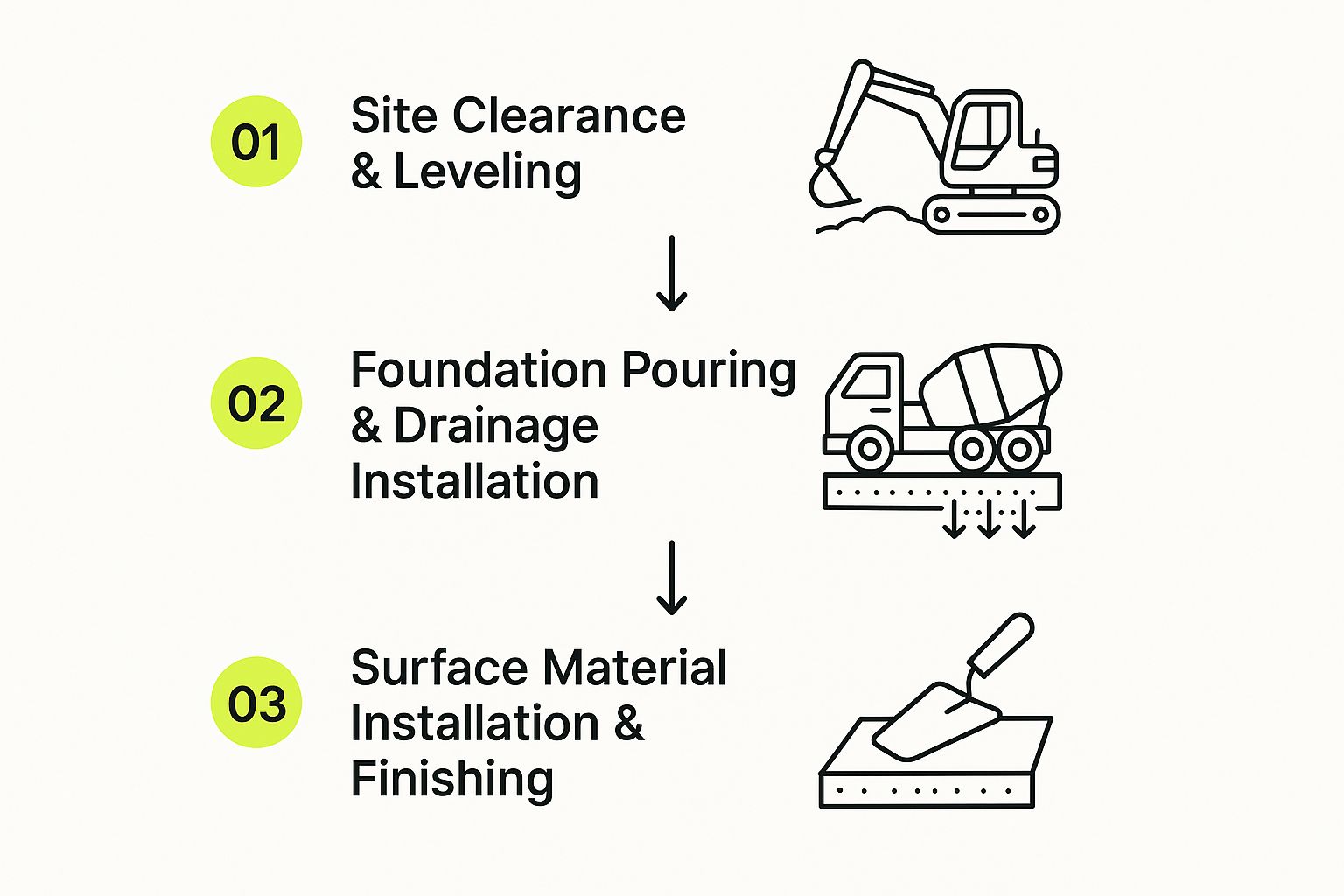
This visual really drives home how a solid build starts with robust earthworks and a perfect foundation, setting the stage for everything else.
Assembling the Structure and Glass
Once the foundation is cured and ready, the court’s skeleton starts going up. The steel or aluminum frame is erected piece by piece, anchored securely into the concrete base. This demands incredible precision—every post has to be perfectly vertical and aligned.
Next up is the glass, a delicate but vital step. Those huge, heavy panels of tempered glass are carefully lifted into place and secured to the frame. Installers use specialized suction cups and work methodically to prevent any chips or cracks. The fit has to be exact, with rubber or neoprene gaskets cushioning the glass from the metal to absorb impacts and allow for temperature changes.
As you get into the thick of construction, make sure everyone on-site knows the safety protocols. It's always a good idea to understand things like CSCS card requirements for construction sites to keep the environment professional and safe for everyone involved.
Installing the Turf and Finishing Touches
With the structure locked in, it's time to roll out the playing surface. The artificial turf comes in big rolls that are cut and seamed together using high-strength adhesive tape. You want those seams to be invisible, creating a single, uniform playing field.
After the turf is down, the most important part for gameplay begins: the sand infill. We spread kiln-dried silica sand evenly across the whole surface, usually about 12-15 kg per square meter. Then, we brush it deep down into the turf fibers.
This sand is doing a few critical jobs:
- Ball Bounce: It’s what gives padel that consistent, predictable bounce.
- Player Safety: It provides the perfect amount of grip for quick turns while still letting players slide safely.
- Durability: It holds the turf down and protects the fibers from wear and tear.
With the surface done, the final elements go in. The net is stretched to the correct height (88 cm in the middle), the gates are hung, and the lights are mounted and aimed for perfect, shadow-free coverage. If you're building an enclosed facility, our guide on indoor padel courts has some great tips on lighting and ventilation. Every last detail gets checked and double-checked to make sure the court isn't just built, but built for an amazing playing experience.
Breaking Down Costs and Your ROI
Alright, let's talk numbers. Because at the end of the day, understanding the financials is what turns a great idea for a padel court into a profitable business. The total investment for your padel court construction is way more than just the price of the court itself. Think of it as a complete project with several key stages, each with its own price tag.
You need a realistic budget that covers everything from breaking ground to flipping on the lights for the first time.
The True Cost of Building a Padel Court
The final number on your invoice is going to swing wildly depending on the specs you choose. A simple, open-air court for your backyard is a completely different beast than a premium, club-level panoramic court built for heavy, commercial use. For a really detailed look at the numbers, check out our guide on padel court construction cost.
But for now, here are the main cost centers you absolutely have to plan for:
- Site Preparation: This is all about clearing, leveling, and compacting the ground. If you're starting with a sloped piece of land or an area with bad drainage, expect these costs to climb.
- Foundation: A solid, reinforced concrete slab is non-negotiable. The price here will depend on local concrete costs and how thick you need to pour it (usually 15-20 cm).
- Court Structure: This is the big one—the steel frame, the glass walls, and the fencing. A standard court is easier on the wallet, while a panoramic design with 12mm tempered glass is a top-tier investment.
- Lighting System: To get the most playing hours out of your court, professional LED lighting is a must. The cost is directly tied to how many fixtures you need and their quality.
- Labor and Installation: Don't ever skimp on this. Paying for a professional crew ensures your court is safe, built to last, and meets all the official standards.
Maximizing Your Return on Investment
Building a court is an investment, plain and simple. And like any good investment, it needs to pay you back. With the world going crazy for padel, the business opportunity is massive. To figure out if your project will be a financial success, getting a firm grip on how to calculate return on investment is essential.
The market trends are definitely on your side. The Padel Court Market was valued at a whopping USD 3.81 billion in 2023 and is projected to more than triple, hitting around USD 12.51 billion by 2031. That explosive growth is powered by a steady compound annual growth rate (CAGR) of 14.21% between 2024 and 2031. The demand is real and it's global.
Your court isn't just a playing surface; it's a revenue-generating asset. The key is to build multiple income streams around it to accelerate your ROI and create a thriving community hub.
Here's how you can build a solid business model around your court:
- Court Rentals: This is your core income. Get smart with dynamic pricing—charge more for those prime-time evening and weekend slots and offer deals for off-peak hours to keep the court full.
- Coaching and Academies: Bring in the pros. Offering private lessons, group clinics, and programs for kids attracts dedicated players who will book courts over and over again.
- Leagues and Tournaments: Nothing keeps courts booked like organized play. Charge entry fees for competitive events to add another revenue stream and build a loyal player base that keeps coming back.
- Pro Shop and Amenities: Don't stop at the court. Selling rackets, balls, and apparel adds to your bottom line. A small café or snack bar can also boost profits and make your facility the place everyone wants to hang out.
By stacking these revenue streams, you turn that initial construction cost into a business that can grow and profit for years to come.
Common Padel Court Construction Questions
Jumping into a padel court project always brings up a ton of questions. You’ve got the big stuff like materials and costs figured out, but it's the smaller, practical details that often trip people up and wreck timelines and budgets. Getting solid answers to these common questions upfront is the best way to avoid rookie mistakes and move forward like a pro.
Think of this as your quick-fire Q&A. We've pulled together some straightforward answers based on what we’ve seen in real-world court builds to help you make smarter decisions from day one.
How Much Space Do You Really Need for a Padel Court?
This is always the first question, and for good reason. The answer isn't just about the playing area. Sure, a regulation padel court is 10 meters wide by 20 meters long, but that's just where the game happens. You absolutely have to account for the space around the court.
For basic safety and access, you need a runoff area. We always tell people to plan for a minimum total footprint of 11m x 21m for a single court. This gives you just enough breathing room for players to chase a ball outside the court and for maintenance crews to get in and out.
Now, if you're dreaming bigger and planning multiple courts, the math gets more complicated.
- Walkways and Access: You need comfortable space between courts so people aren't bumping into each other. Don't forget about emergency access, either.
- Amenities: This is what turns a few courts into a real club. You'll need room for player benches, water stations, and maybe even a small viewing deck or social area.
A huge—and expensive—mistake we see all the time is underestimating this extra space. A cramped facility doesn't just feel cheap; it can be a genuine safety hazard. Always, always get a professional site survey done before you commit a single dollar to the project.
What Is a Realistic Timeline for Building a Padel Court?
The on-site construction itself can be surprisingly fast. Once the foundation is prepped and ready, a single court can go up in just four to six weeks. That breaks down to about one to two weeks for pouring and curing the foundation, then another two to four weeks for erecting the structure, installing the glass, laying the turf, and adding the finishing touches.
But here’s the catch: that timeline doesn't include the pre-construction phase. This is where the real delays hide.
The biggest wildcard is always the permits. Depending on where you live, getting the green light from your local municipality can take a few weeks or drag on for several months. Never assume it'll be quick.
On top of that, if your site needs a lot of work—like major excavation, grading, or a complex drainage system—you can easily tack on several more weeks. It’s smart to build a generous buffer into your timeline to account for things you can't control, especially bad weather.
How Much Maintenance Does a Padel Court Require?
One of the best things about modern padel courts is that they are pretty low-maintenance. But low-maintenance doesn't mean no-maintenance. A little bit of consistent upkeep goes a long way in protecting your investment and making sure the court plays great for years.
Your main job will be taking care of the artificial turf. The single most important task is regularly brushing the surface to keep the silica sand infill spread out evenly. Plan on doing this weekly or bi-weekly, depending on how heavy the court usage is.
Here’s a simple checklist to stay on top of it:
- Brush the Turf: This is non-negotiable. It keeps the sand level for a true ball bounce and stops the turf fibers from getting matted down.
- Top Up the Sand: You’ll lose a little sand over time. Periodically, you'll need to add more to maintain the right depth.
- Clean the Glass: A quick wipe-down of the glass panels keeps visibility perfect for players and anyone watching.
- Inspect the Structure: Do a regular walkthrough. Check the net tension and give the steel frame and fencing a once-over for any signs of rust, wear, or damage.
A simple, repeatable maintenance schedule is the secret to keeping your court in pristine condition and ensuring everyone has an amazing playing experience.
At Padel Rumors, we provide the in-depth guides and resources you need to navigate every aspect of the sport, from playing your first game to building your own court. Explore our expert advice at https://padelrumors.pages.dev.


